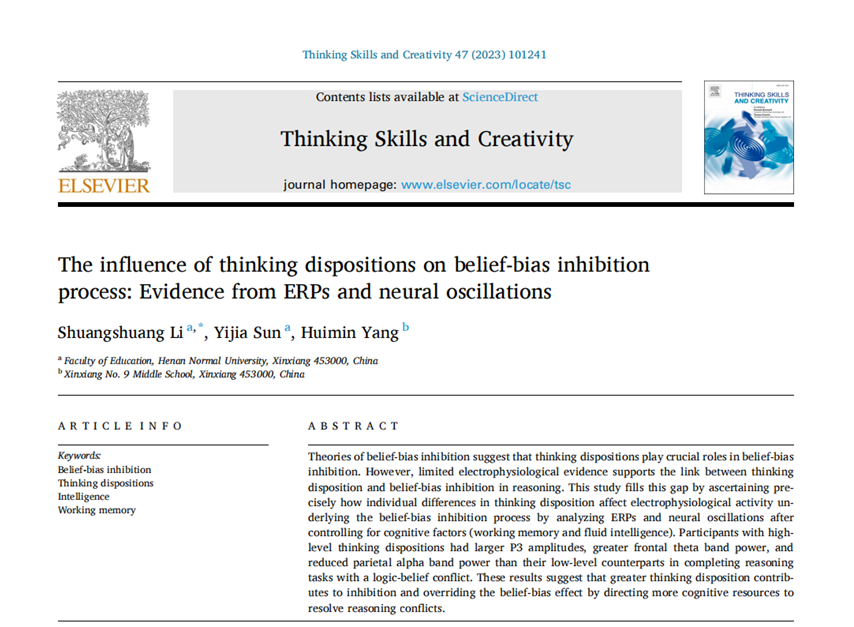1.胡金艳,高兴启,满其峰,张义兵. 知识建构社区中观点演化模型的构建——基于多主体模拟的分析方法[J]. 现代教育技术,2023,33(03):109-117.
目前,对知识建构社区中观点演化的研究存在惯性地沿袭还原论的研究范式、聚焦于对单个观点甚至是片段化的关键词进行挖掘等问题,导致观点群体层面的行为与属性被简化,其演化规律也成为了“黑箱”。基于此,文章采用自下而上的多主体模拟方法,构建了观点演化模型,探索了非叠加态的多个观点如何聚集成团并持续演化,发现:观点交互意愿影响其演化过程,聚集成团的临界值为53%;有组织社团结构的生成与观点交互意愿呈非线性的发展关系;21%的异质扰动可以打破观点“种族隔离”状态并形成新的稳定结构。文章的研究为观点演化的探索提供了全新的视角与方法,对知识建构教学实践具有重要的指导意义。
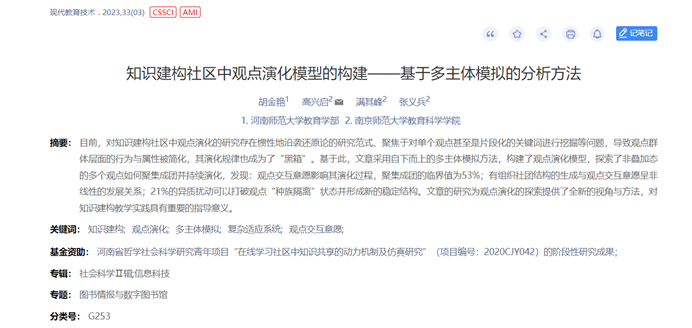
2.崔振成,李志前. 道德主体性与伦理他者性的融合:儒家伦理思想的德育价值转化[J]. 河南师范大学学报(哲学社会科学版),2023,(01):151-156.
儒家伦理思想秉持道德主体性与伦理他者性一体融合的价值立场。道德主体性表现为内在超越与刚健有为;伦理他者性体现为主体间伦理互系共在、主体对社群的使命与责任担承;道德主体性与伦理他者性的一体融合即内圣与外王在个体道德生命建构中的伦理融化与统摄守一,这一伦理设计有效规避了主体的“单子式”僭越、主体间的伦理冲突以及主体与社群间的价值裂解。在廓清儒家伦理思想的历史局限性并保持必要的文化警惕前提下,儒家道德主体性与伦理他者性一体融合的伦理思想为当代德育理论与实践提供了双重价值参鉴。在理论理性上,当代德育首先应致力于受教育者道德主体性的生成与发展,培育其他者性伦理格局与使命自觉,最终实现道德主体性与伦理他者性的一体融合;在实践理性上,当代德育要注重道德体验与伦理实践的方法与路径。
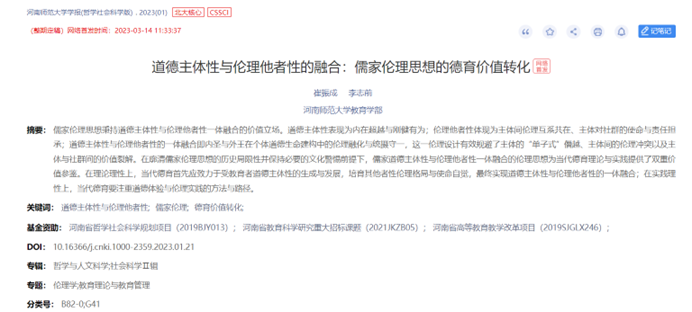
3.吴春阳,夏梦萱,赵睿睿. 微时代弘扬黄河文化的实然困境与应然进路[J]. 新闻爱好者,2023,(02):73-75
黄河文化是中华民族的根与魂,蕴含着极其丰富的精神内涵和时代价值。弘扬黄河文化是构建中华民族命运共同体的必然选择,是涵养社会主义核心价值观的动力之源,是提升中国文化软实力的战略之举。微时代在弘扬黄河文化的过程中,面临着现实问题与文化阐释的张力、国家意志与行政逻辑的落差、价值多元与西方文化的渗透、区域传统文化的趋同与求异、传承载体与传播渠道的局限等现实困境。需要围绕多元主体协同推动、资源要素优化整合、载体渠道融合共生、弘扬机制建构完善等方面,探索保护、传承、弘扬黄河文化的应然进路。
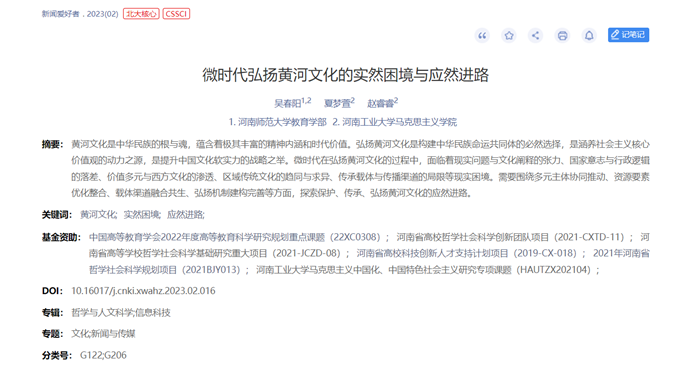
4.李益. 校园空间的育人逻辑及其活化利用[J]. 中国教育学刊,2023,(02):99-102.
校园空间并非单纯的物理场景,其本身也具备育人的属性。校园空间独特的育人追求不仅在于制度层面规范学校整体,通过文化建设建构社会空间形态,还在于通过和谐人际关系营造道德规范化的“熟人空间”以及达成共识的“道德净土”空间。在教育实践中,既需要以物的持续改造优化校园空间,还可依托教育技术拓展校园空间,并经由文化互动丰富校园空间。在此过程中,教育实践与空间活化利用持续互动建构,可经由教育空间的活化利用增进育人价值、塑造关系空间。由此,探索出校园空间活化利用的有效路径:持续改造物质场所,完善空间育人功能;营造主题式共享空间,深化学生人文底蕴;构建多样化公共空间,充实学生精神力量;建设多功能开放空间,增强实践创新能力。
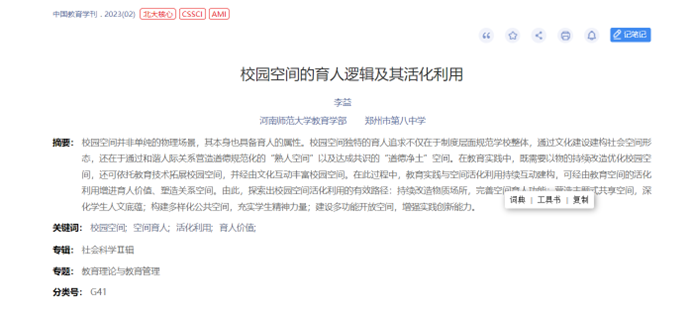
5.朱珂,张晨雨,刘玉莹,高清慧. 国际视阈下教育发展增值评价模型的比较研究[J]. 远程教育杂志,2023,41(01):60-71.
增值评价兼顾教育对质量和公平两个维度的追求,契合新时代教育评价改革的价值意蕴,对教育评价具有重要实践意义。增值评价成功实施的关键在于对增值模型的选择与应用。首先,依据增值评价发展脉络和统计技术发展水平,将增值模型的发展划分为萌芽、兴起、发展和成熟四个阶段,并根据评价测量类型的不同,划分为横截面测量模型和纵向测量模型。其次,从数据来源、学生群体、缺失数据处理、实践应用、模型特征五个方面介绍了十大经典增值模型;以采用纵向数据测量设计的教育增值评价系统EVAAS为例,从评价过程和结果应用两个方面介绍国际增值评价模型的实践发展。最后,从技术赋能、证据来源、评价内容和评价标准四个方面,对依托教育元宇宙的支持、构建基于循证的全域证据链、发展综合性增值评价和实现差异化增值评价进行展望,以期为增值评价的实施提供理论借鉴。
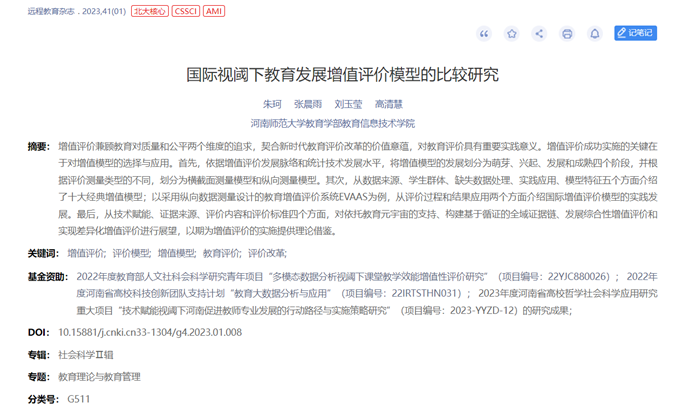
6.付艳萍,张晓阳. 何谓英才,谁的教育,如何教育——美国英才教育发展中的三大论争[J]. 全球教育展望,2023,52(01):118-128.
美国现代意义上的英才教育发端于20世纪20年代。在其百年发展历程中,美国学界围绕三大核心议题展开持续论争:“何谓英才”“谁的教育”以及“如何教育”,分别涉及英才的定义、选拔标准以及英才教育的实践形式。论争背后,“公平”与“卓越”两大价值取向之间的博弈贯穿其中,而美国英才教育也在公平质疑中不断发展。开展英才教育既是实现英才儿童个体潜能最大化发展的重要举措,也是推动社会创新、增进民族福祉的国家战略选择。对于我国而言,应加快建立英才教育体系,助益创新型国家建设和人才强国战略的实施。
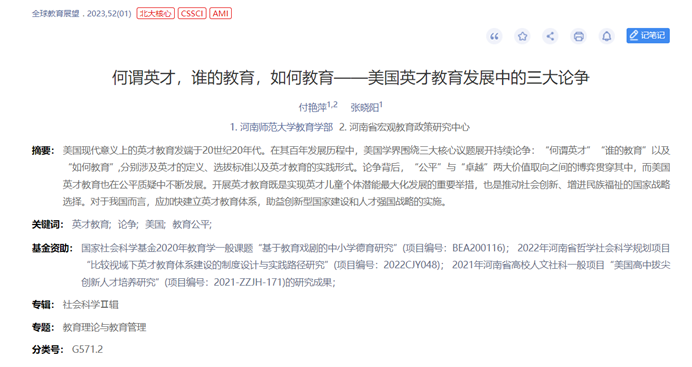
7.吴春阳,张宝强,丁笑生. 组织变革视角下现代大学书院制革新的逻辑理路[J]. 江苏高教,2023,(01):59-65.
现代大学书院制学生教育管理模式是高校践行“全人教育”理念、回应一流本科教育应然使命、落实立德树人根本任务创新组织形态的革新之举。而组织形态的变革受到主体需求、战略规划、环境影响和信息技术发展等因素的综合作用。当前,各高校在实施书院制时主要存在战略规划意图不清、体制机制建构不足、双院协同内在冲突和信息技术应用不够等共性问题。因此,高校在构建书院制学生教育管理模式时,要结合学校治理现状,从战略规划的发展性思维体现、多元主体的主体性作用发挥、体制机制的协同性创新推动、教育场域的信息化转换重构和组织文化的生态化演进转向等维度出发,探索构建契合信息时代特征、适应大学治理发展需要、彰显学校育人特色的现代大学书院制学生教育管理模式。
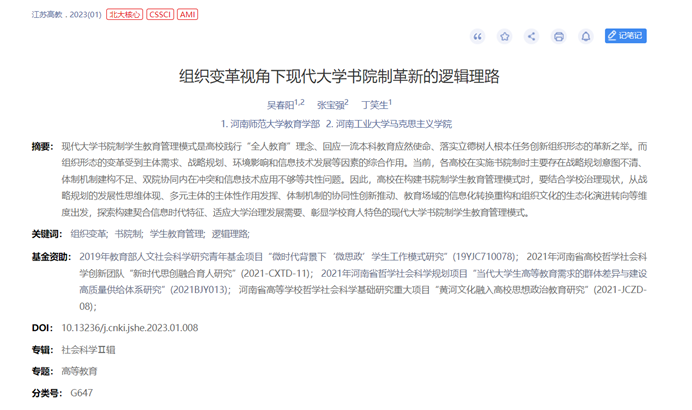
8.朱珂,张斌辉,宋晔. 技术生态位视阈下“人工智能+教育”的融合逻辑与模型构建[J]. 电化教育研究,2023,44(01):13-19.
人工智能与教育的融合创新对教育生态系统的迭代升级产生了革命性影响。为探析人工智能与教育深度融合的运行机理,从技术哲学和技术生态位的视角出发,运用理论分析法揭示技术竞争机制,构建“人工智能+教育”的生态系统模型。模型包含微观、中观和宏观三个层次,以发现竞争意向为支撑,奠定微观层的哲学根基;以显现演化机制为核心,总结中观层的运行规律;以实现深度融合为目的,构建宏观层的系统表征。从技术与技术、技术与教育主体协同竞争的两个维度,激活技术潜力,激励教育主体,主动把握人工智能重塑教育生态系统的发展趋势。模型在理论深度上尝试明晰竞争机制,厘清演化关系;在时间跨度上能够贯穿竞争全程,打造循环生态;在范围广度上能够协调竞争和融合,涵盖人工智能和教育主体,对人工智能教育的理论和实践发展具有一定的借鉴意义。
9.Sun, W., Liu, L., Jiang, Y., Fang, P., Ding, X., & Wang, G. (2023). Academics–Athletics Conflict and College Athletes’ Well-Being: The Mediating Effect of Negative Emotions and the Moderating Effect of Life Motivation. Behavioral Sciences, 13(2), 93. https://doi.org/10.3390/bs13020093
Abstract: For college athletes who perform dual roles (student and athlete), the academics–athletics conflict is inevitable in daily life. Although existing studies have focused on the adverse effects of this conflict on the well‐being of college athletes, they have not yet determined the underlying mechanism and effective measures to alleviate it. To explore the underlying mechanism of academics–athletics conflict, which affects the well‐being of college athletes, we constructed a moderated mediating model to examine the critical role of negative emotions and life motivation in the relationship between them. The study randomly selected 802 college athletes from China to examine the relationships between academics–athletics conflict, negative emotions, eudaimonic motives, hedonic motives, and life satisfaction. The results showed that (1) negative emotions played an important mediating role between academics–athletics conflict and college athletes’ life satisfaction, with more than 79% of the effect of academics–athletics conflict being achieved through negative emotions. (2) Eudaimonic motives significantly moderated the first half of the mediation path of negative emotions between academics–athletics conflict and life satisfaction. Individuals with high eudaimonic motives experienced fewer negative emotions in the medium and weak conflict conditions. (3) Hedonic motives had a significant moderating effect on the second half of the mediation path. Individuals with high hedonic motives had greater life satisfaction across negative emotion conditions. This study provides important insights for a comprehensive understanding and in‐depth study of the relationship between conflict and the well‐being of college athletes, as well as a reference for the quality‐of‐life enhancement and motivation development for college athletes.
Keywords: academics–athletics conflict; life satisfaction; negative emotions; eudaimonic motives; hedonic motives
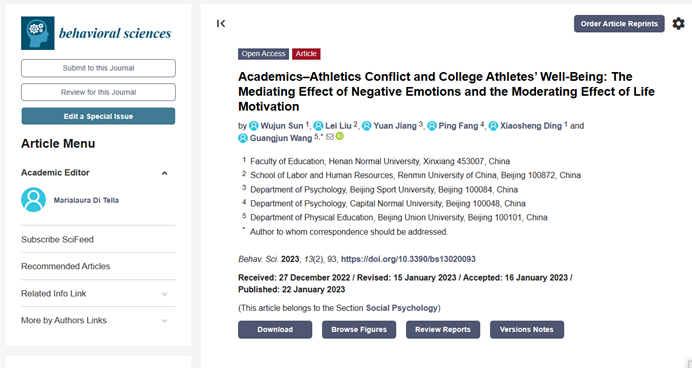
10.Zhao, H., Zhang, M., Li, Y., & Wang, Z. (2023). The relationship between a growth mindset and junior high school students’ meaning in life: A serial mediation model. Behavioral Sciences, 13(2), 189. (SSCI; JCR二区; 中科院四区).
Abstract: A growth mindset is an individual’s belief that human intelligence can be changed through continuous practice and effort. The meaning in life signifies that individuals understand or see the meaning of their own life and are aware of their own goals and the values of their own life. Previous studies have shown that a growth mindset positively promotes individual emotional health and life happiness, but its relationship with meaning in life needs to be clarified. In this study, taking the self-determination theory and the broaden-and-build theory of positive emotions as a basis, we constructed a serial mediation effect model to test the mechanism of psychological capital and core self-evaluation in the relationship between a growth mindset and the meaning in life. A total of 565 students from Chinese junior middle schools participated in this study. The growth mindset, meaning in life, psychological capital, and core self-evaluation scales were used to collect the data for the study. The results indicated the following: (1) meaning in life was significantly predicted by growth mindset (b = 0.181, p < 0.001); (2) psychological capital and core self-evaluations played a mediating role in the influence of growth mindset on junior high school students’ meaning in life. The mediating role includes three mediating paths: the individual mediating effects of psychological capital, the individual mediating effects of core self-evaluations, the serial mediating effects of psychological capital and core self-evaluations. The results of this study confirm the benefits of a growth mindset, as well as the potential mechanism by which they impact meaning in life, which positively impacts junior high school students meaning in life.
Keywords: junior high school students; growth mindset; meaning in life; psychological capital; core self-evaluations; serial mediation
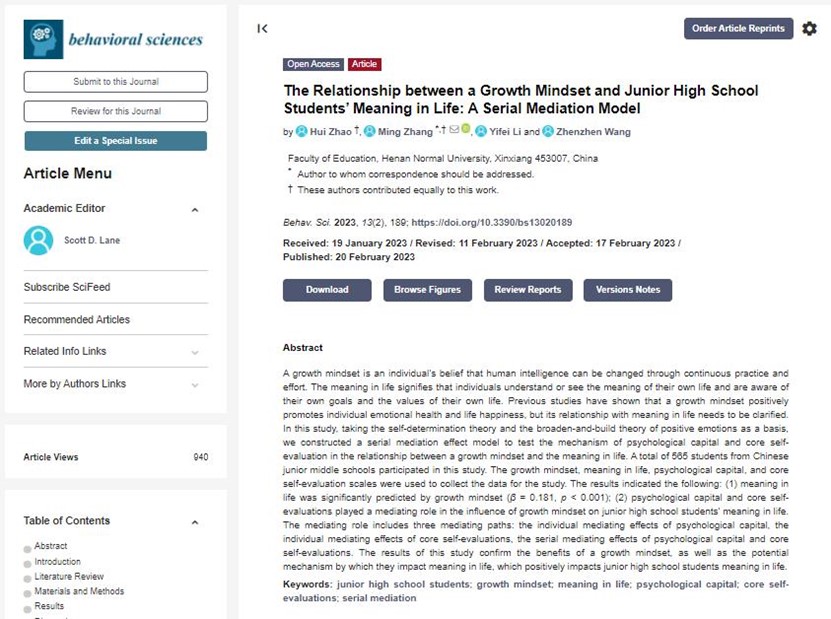

11.Li, S., Sun, Y., & Yang, H. (2023). The influence of thinking dispositions on belief-bias inhibition process: Evidence from ERPs and neural oscillations. Thinking Skills and Creativity, 47, 101241.https://doi.org/10.1016/j.tsc.2023.101241
